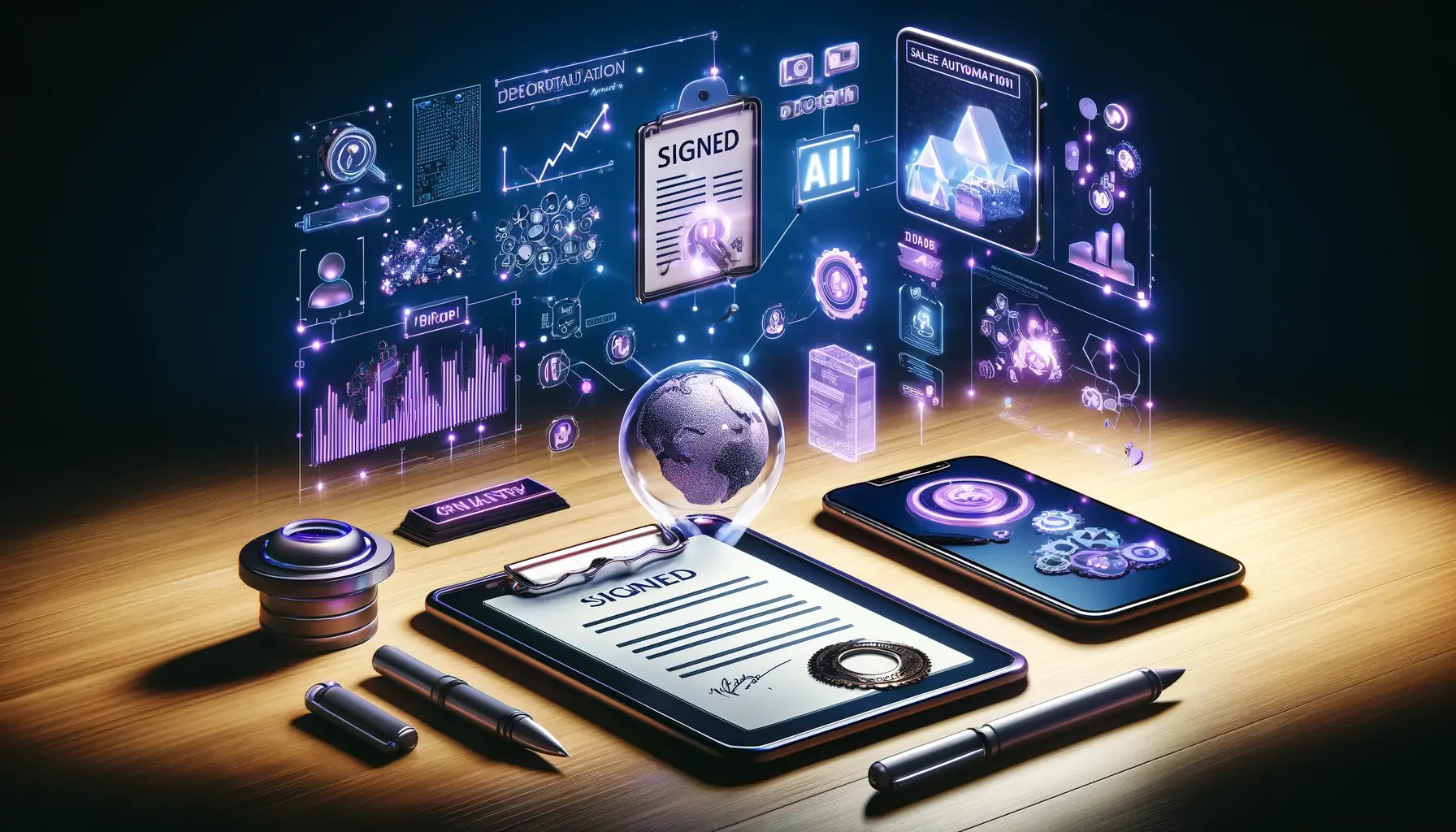Sales Automation with an AI Virtual Assistant: What Is It and How to Use It?

AI assistants have advanced leaps and bounds with generative AI. Learn how to use them in sales
Many of today’s virtual assistants are so advanced that it’s hard to tell whether they’re real or AI. They can answer complex questions, solve math problems, and even maintain a complete conversation.
Some AI virtual assistants are so capable that they can even handle sales automation and streamline workflows so that teams can focus on developing high-level strategies and closing deals.
In this blog, we’ll go over what AI virtual assistants are, as well as how you can integrate certain ones like AiSDR into your sales process.
What is an AI virtual assistant?
AI virtual assistants use natural language processing (NLP) algorithms to understand queries and provide accurate, human-like responses. They can process complex questions and commands, provide insightful answers, and perform daily tasks like scheduling and crafting emails.
Types of AI virtual assistants
Have you ever asked Alexa to order something for you?
If yes, then congrats! You’ve interacted with an AI virtual assistant. But did you know there are many types of amazing AI assistants geared for unique communication flows?
Chatbots
Rule-based versions of chatbots, or those capable of responding only to simple queries and managing administrative tasks, still exist. But since the launch of ChatGPT, their generative AI counterparts have been stealing the spotlight.
Modern chatbots are equipped with more powerful features that allow them to answer open-ended questions, address technical concerns, collect customer information, recommend products and helpful content, and handle sales objections.
They can also automate customer interactions to help your employees focus on value-added work.
Voice assistants
Gone are the days when users could only interact with voice assistants by listening to a voice prompt and pressing certain numbers in response.
AI voice assistants like Amazon’s Alexa and Apple’s Siri have upped the game. Their key features tap into the use natural language processing (NLP) to comprehend human speech, allow users to ask open-ended questions or give complex voice commands, and respond accordingly.
AI avatars
When thinking of AI-powered tools, many expect the wit of J.A.R.V.I.S. from Iron Man and the cunning of HAL 9000. For better or worse, we’re not there yet.
Still, AI avatars have evolved to become more human-like than their traditional counterparts, capable of handling more complex tasks.
From facial features and expressions to body movements, they resemble human beings to a sufficient degree, creating a sense of relatability. They’re also able to understand and give comprehensive responses to text and voice.
The evolution of such AI-powered automation tools continues thanks to tech like the NVIDIA Avatar Cloud Engine (ACE) that brings 2D and 3D avatars to life using generative AI.
Domain-specific virtual assistants
If you’re looking for a specialized AI with more advanced features that can provide service to users in your industry, you’ll want to look for a domain-specific virtual assistant.
The knowledge and data they possess can be put to do the heavy lifting in the industry they’re designed for. That’s why you’ll frequently encounter them in fields such as finance, cybersecurity, healthcare, and other demanding sectors.
For example, IBM Watson Health is a domain-specific virtual assistant that handles complex tasks such as recommending treatment plans, therapies, and other medical options. The features it offers and information it provides go beyond what general AI tools can achieve.
Characteristics of AI virtual assistants
What sets modern AI assistants apart from their older versions are their special features and capabilities.
Button-based chatbots and Interactive Voice Response assistants were limited in features and only allowed users to select from a menu of questions. Now not only can AI assistants ask and give accurate answers to questions in real time, but they can sustain a back-and-forth conversation.
Conversational interface
The more NLP improves a virtual assistant’s ability to understand questions, the more users can enjoy natural conversations.
Customers no longer have to deal with pre-programmed content prompts that are rigid and limited to their initial design. Instead, businesses can use Conversational AI assistants to handle first-touch interactions and follow-ups. As a result, the quick response and fast time-to-value deliver a more enjoyable customer experience.
Task automation
To eliminate some of their workload, customer support teams can delegate their daily tasks of answering common questions or suggesting the right knowledge base articles to AI , taking over only when the AI flags a customer as having a serious issue requiring human intelligence.
This showcases both AI’s recognition of when it can and can’t offer insightful answers, as well as its ability to redirect questions to the appropriate support agent.
Sales and marketing teams can also capitalize on these powerful features. By sharing frequently asked questions and how to address them, the AI writing assistant can quickly reply to leads when they’re still engaged and thinking of the company. Not only does this keep leads warm, but it saves teams from constantly monitoring their inbox.
Context awareness
AI virtual assistants have made dramatic strides in understanding a customer’s sentiment, buyer intent, and location in their customer journey. They can now “recall” previous interactions across multiple platforms and adjust the content to match, which is an essential feature of omnichannel outreach.
On top of that, AI sales assistants like AiSDR can contextualize their responses and refer to previous messages. This prevents the AI from getting locked into a so-called “death spiral” where it loops back around to an initial question.
Learning and adaptation
Thanks to machine learning, AI virtual assistants can take new information from every customer interaction and apply it to improve their responses. This helps them fine-tune the way they communicate and generate better content.
Such an iterative learning loop allows them to continuously improve at anticipating user needs and delivering accurate information. Alexa and Siri are two well-known examples of virtual assistants that use machine learning features to sound more human-like with every conversation.
Multi-functional capabilities
Smart virtual assistants go beyond just responding to common customer support queries. When they’re made right, they can handle a wide range of routine tasks, including booking meetings on the calendar and setting appointment reminders, creating meeting summaries, reading auto-replies and referrals before taking the appropriate action, and handling sales objections.
Without burning your budget, they become indispensable collaboration tools that cover many bases while scaling operational efficiency.
For instance, AiSDR features cover all the heavy lifting for cold outbound from first-touch emails to follow-ups and pitching leads to book a meeting. They can also process referrals by closing one lead and adding the new prospect to the ongoing outreach campaign.
Integrations with other software
AI virtual assistants can integrate seamlessly into your existing systems. You can connect them to your email, enterprise system, customer relationship management software, or collaboration tools.
As an example, AiSDR connects to both Calendly and HubSpot calendars, and it also syncs active and static HubSpot lists for future email outreach.
Some AI writing assistants like AiSDR can even communicate with leads across different channels like text and email.
Cross-platform availability
To make the most out of your AI virtual assistants, you’ll want to double-check if they work with different devices and platforms like iOS, Android, MacOS, and Windows. It’ll be a lot more convenient if you’re able to switch from one gadget to another hassle-free. And, of course, the AI assistants should work seamlessly with your existing office software.
How to implement AI virtual assistants in sales automation
Let’s take a closer look at how you can integrate AI tools into your sales process.
Assess your sales processes
Start by mapping out your workflows, then identify repetitive tasks in your daily routine that the sales virtual assistant can take over. Common responsibilities that are well-suited for an AI sales assistant include managing calendar meetings, follow-ups, and lead nurturing.
Pick the right AI tool
Once you’ve determined the role your sales AI will fill, it will be a lot easier to pick the right virtual assistant for sales.
Before you subscribe, make sure your new AI-powered automation tool has the special features for carrying out your business needs and integrating with your existing software. If you’re able to narrow down your options to a shortlist, it might be worthwhile to see if there are any that support a free trial.
Integrate with your current CRM and sales tools
Once you’ve settled on the virtual sales assistants you want, it’s time to set them up.
Some AI-powered tools provide self-explanatory onboarding flows are user-friendly and straightforward in their implementation. But if you have a dedicated customer support team that’s at your disposal 24/7, now’s a good time to use it.
Onboard your sales team
Once you’ve set up your new AI tools, it’s time to teach your team how to use the new powerful features they now have.
A tool that has an onboarding process filled with friction and gaps is going to result in a tool that doesn’t get used. Again, this is an area where having a customer success team to turn to will pay massive dividends in customers familiarizing themselves with all of the special features and developing a habit that turns into long-term adoption.
Scale gradually
You may need to scale using AI-powered tools as your business grows. Or you might simply find more use cases with the same features as you start implementing them.
In either case, scaling is best done gradually.
Start by trialing basic or essential use cases, then expand as you gather insights and learn how the AI-powered automation tools aid your processes and bottom line. You might start off by having your conversational AI assistant run outreach campaigns to schedule meetings before expanding it to answer inbound queries and handle sale objections.
Examples of AI virtual assistants
Here are some examples of an AI virtual assistant that’s automated tasks for hundreds of users.
Siri
Made for the Apple ecosystem, Siri is an AI-powered virtual assistant that provides comprehensive responses to voice queries and gesture-based controls in real time. Its special features allow Siri to give accurate answers to open-ended questions, provide product recommendations, and perform tasks (like making appointments and providing directions as you navigate a new neighborhood). Its natural-language interface allows users to interact with the AI-driven virtual assistant in naturally flowing conversations.
Cortana
Developed by Microsoft, Cortana responds to text and voice commands, digging into the Bing search engine to answer questions and provide weather forecasts. This conversational AI virtual assistant has built-in flows for sending emails, making appointments, organizing calendars, triggering alerts, and tracking packages. Sales teams can use it to manage the sales pipeline by integrating it with your CRM to monitor the status of deals and send email updates.
Alexa
Amazon’s Alexa leverages NLP to respond to voice commands and complete various tasks, including creating to-do lists, delivering the latest news, setting alerts, and ordering products online. Alexa works with several smart devices, including speakers, WiFi plugs, and security cameras.
Businesses can use Alexa to increase sales by elevating the customer experience. For example, restaurants can configure it to allow customers to order food on the go.
AiSDR
AiSDR is an AI-powered automation tool that enhances sales teams’ productivity with features like prospecting, lead qualification, setting up sales meetings, and prospect nurturing. It can also shoulder some of the load for market research by conducting market research, sending surveys, and collecting responses.
This AI virtual sales assistant can even write email and text messages that look and sound like you wrote them.











